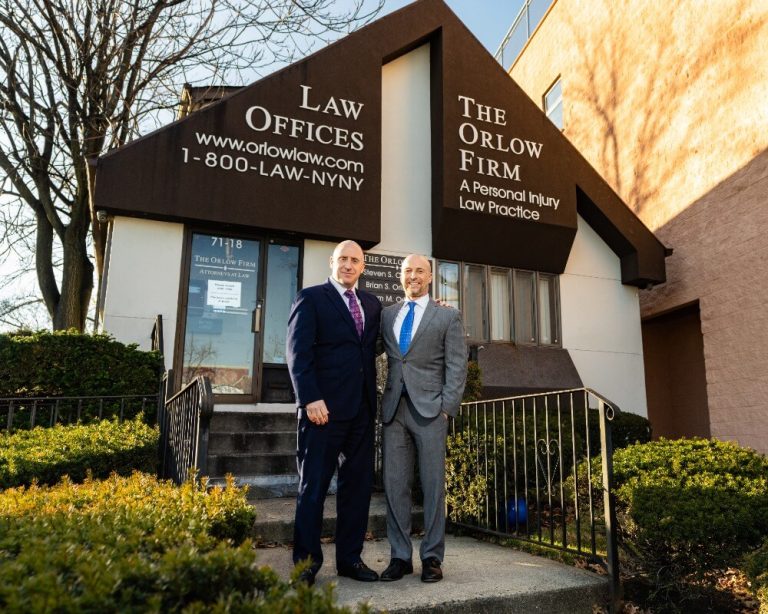The Following People Contributed to This Page
Cindy Cordova is a seasoned legal writer with over seven years of experience crafting clear, informative, and professional content for law firm websites. With a B.A. in English from Trinity Christian College, she combines her strong writing background with a deep understanding of legal topics to help firms connect with their clients through trustworthy and accessible content.
- June 4, 2025
At What Age Can Kids Sit in the Front Seat of a Car in New York?
Quick Answer: New York State law mandates that all children under the age of 16 must be properly restrained in a vehicle. However, the law does not specify an exact age when a child can legally sit in the front seat. Instead, it focuses on the use of appropriate child restraint systems based on the child’s age, weight, and height. If your child has been injured, our compassionate and experienced car accident attorneys can provide guidance tailored to your situation. Call us today at (646) 647-3398 for a consultation.
New York State Law on Child Passengers
When it comes to the safety of children in vehicles, understanding the laws and recommendations is crucial for parents and guardians. In New York, specific regulations govern when a child can sit in the front seat of a car. This blog post aims to clarify these rules and provide guidance to ensure the safety of young passengers.
Recommendations for Front Seat Safety
While the law may not specify an age, safety experts and organizations like the American Academy of Pediatrics (AAP) provide guidelines to help parents make informed decisions:
- Children Under 13 : It is generally recommended that children under the age of 13 ride in the back seat. This is because the back seat is considered safer, especially in the event of a collision.
- Airbag Risks : Front airbags are designed for adults and can pose serious risks to children. The force of an airbag deploying can cause injury to a child, especially if they are not properly restrained or are sitting too close to the dashboard.
Factors to Consider
If you are considering allowing your child to sit in the front seat, here are some factors to consider:
- Size and Weight : Ensure your child meets the height and weight requirements for using the vehicle’s seat belt properly.
- Maturity Level : Consider whether your child can sit properly without slouching or leaning forward, which can compromise the effectiveness of the seat belt.
- Vehicle Type : Some vehicles have advanced airbag systems that can detect the presence of a child and adjust deployment accordingly. Check your vehicle’s manual for specific safety features.
Ensuring Compliance and Safety
To ensure compliance with New York State laws and maximize your child’s safety:
- Use Appropriate Restraints : Follow the manufacturer’s instructions for car seats and booster seats. Transition to a seat belt only when your child is ready.
- Regularly Check Fit : As your child grows, regularly check that their car seat or booster seat fits correctly and that the seat belt lies across the shoulder and chest, not the neck or face.
- Educate Your Child : Teach your child the importance of car safety and the reasons behind sitting in the back seat.
Conclusion
While New York law does not specify an exact age for when a child can sit in the front seat, safety guidelines suggest waiting until they are at least 13 years old. Prioritizing your child’s safety by following these recommendations can help prevent injuries and ensure peace of mind while driving.
If you have any questions about child passenger safety laws or need legal assistance related to a car accident, The Orlow Firm is here to help. Contact us at (646) 647-3398 for a free consultation with our experienced personal injury attorneys. We are committed to protecting your rights and ensuring your family’s safety.
Understanding New York State Laws for Kids Sitting in the Front Seat
Understanding At What Age Can Kids Sit in the Front Seat of a Car in New York? is crucial for ensuring the safety of young passengers and avoiding potential legal issues. In New York State, including New York City, there are specific guidelines and laws that regulate when a child can legally sit in the front seat of a vehicle. These laws are designed to protect children from injury during car rides, and knowing them can help parents and guardians make informed decisions.
In New York, the law does not specify a minimum age for when a child can sit in the front seat. However, it strongly recommends that children under the age of 13 ride in the back seat. This recommendation is based on safety considerations, as airbags in the front seat can pose serious risks to young children in the event of an accident. Airbags are designed for adult-sized passengers and can cause injury to a child due to their forceful deployment.
For children who do sit in the front seat, New York State law mandates that they must use a proper restraint system. This includes:
- Child Safety Seats: Children under the age of 4 must be secured in a federally approved child safety seat. This applies regardless of whether they are sitting in the front or back of the car.
- Booster Seats: Children aged 4 through 7 must use a booster seat unless they are 4’9″ tall or weigh more than 100 pounds. This requirement ensures that the seat belt fits properly over the child’s body.
- Seat Belts: Once a child outgrows the need for a booster seat, they must use a seat belt. It’s important that the seat belt fits snugly across the upper thighs and chest, not on the stomach or neck.
While the law provides these guidelines, it is also essential to consider the specific recommendations from safety experts. The American Academy of Pediatrics, for example, advises that children remain in the back seat until they are at least 13 years old. This recommendation is based on numerous studies showing that the back seat is the safest place for children in the event of a crash.
Understanding these laws and recommendations is vital for parents and guardians in New York City. By adhering to them, you can help ensure your child’s safety on the road. If you have any questions or need legal assistance related to child passenger safety, feel free to contact The Orlow Firm at (646) 647-3398 for a compassionate and professional consultation.
Why Age Matters When Kids Sit in the Front Seat in NYC
When it comes to the safety of children in vehicles, age is not just a number—it’s a critical factor that can significantly impact a child’s safety in the event of a car accident. Understanding why age matters when deciding if a child should sit in the front seat is essential for parents and guardians in New York City.
- Physical Development and Safety – Children are not simply smaller versions of adults; their bodies are still developing, which makes them more vulnerable to injuries in car accidents. The bones of younger children are softer, and their heads are proportionally larger compared to their bodies, making them more susceptible to head and neck injuries. Airbags, designed to protect adults, can pose serious risks to children, especially if they deploy with force while a child is sitting too close.
- Height and Weight Considerations – While age is a primary factor, height and weight also play crucial roles in determining the appropriate seating position for a child in a vehicle. New York State law requires children under the age of 4 to be secured in a federally approved child safety seat. Children under the age of 8 must use a booster seat unless they are taller than 4’9″ or weigh more than 100 pounds. These requirements are designed to ensure that seat belts fit properly, offering maximum protection.
- Legal Guidelines and Recommendations – In New York, it is generally recommended that children under the age of 13 ride in the back seat. This recommendation aligns with guidelines from the National Highway Traffic Safety Administration (NHTSA), which suggests that the back seat is the safest place for children to ride. These guidelines are not just arbitrary numbers; they are based on extensive research and crash test data, indicating that children are at a much lower risk of injury when seated in the rear of the vehicle.
- NYC Traffic Conditions – New York City is known for its dense traffic and frequent stops, which can increase the likelihood of accidents. In such an environment, ensuring that children are seated in the safest possible location within a vehicle becomes even more critical. The combination of stop-and-go traffic and the potential for sudden accidents underscores the importance of following age and size guidelines for seating.
- Parental Vigilance – Ultimately, the responsibility falls on parents and guardians to make informed decisions about their child’s safety in vehicles. This includes not only adhering to legal requirements but also considering expert recommendations and the unique conditions of NYC traffic. By prioritizing safety and understanding why age matters, parents can significantly reduce the risk of injury to their children in the event of an accident.
If you have questions about child passenger safety or if your child has been injured in a car accident, The Orlow Firm is here to help. Our compassionate and experienced attorneys can provide guidance tailored to your situation. Call us today at (646) 647-3398 for a consultation.
Safety Concerns for Children in the Front Seat of a Car
When considering the question of at what age kids can sit in the front seat of a car in New York, it’s crucial to address the safety concerns involved. While New York State law provides certain guidelines, understanding the underlying safety issues can help parents make informed decisions for their children.
- Airbag Risks – One of the primary safety concerns for children sitting in the front seat is the risk posed by airbags. Airbags are designed to protect adults in the event of a collision, deploying with significant force. This force can be dangerous for children, potentially causing severe injuries, especially to those who are younger or smaller in stature. In fact, airbags have been known to cause head and neck injuries to children seated in the front.
- Size and Weight Considerations – Children under the age of 13 are generally advised to sit in the back seat for safety reasons. This recommendation is due to the fact that younger children often lack the size and weight necessary to safely withstand the impact of an airbag. Additionally, seat belts in the front seat are typically designed for adults, which can lead to improper fit and reduced effectiveness for children.
- Proper Restraint Use – In New York, children under the age of 8 must be in a proper child restraint system, which includes car seats and booster seats. Even beyond this age, the use of appropriate restraints is vital. A child’s seat belt should fit snugly across their chest and lap, not their stomach. When seated in the front, it’s more challenging to ensure that the seat belt is positioned correctly, which can increase the risk of injury in an accident.
- Rear-Seat Recommendations – Experts, including the American Academy of Pediatrics, recommend that children under 13 years old sit in the back seat. This position is considered the safest for children, as it is farther away from the impact zone in most accidents. The back seat provides better protection from the force of a crash and reduces the risk of contact with hard surfaces and airbags.
- Urban Traffic Risks – In New York City, the dense traffic and frequent stop-and-go conditions can increase the likelihood of accidents. This urban environment further underscores the importance of adhering to safety guidelines for children in vehicles. Parents should be particularly vigilant about ensuring their children are properly secured in the safest part of the vehicle.
Understanding these safety concerns can help parents in New York make informed decisions about when it’s appropriate for their children to sit in the front seat. If you have any questions or need assistance regarding child passenger safety, The Orlow Firm is here to help. Contact us directly at (646) 647-3398 for more information.
Legal Requirements for Child Car Seats in New York City
Understanding the legal requirements for child car seats in New York City is crucial for ensuring the safety of young passengers. In New York, these laws are designed to protect children from potential injuries in the event of a car accident. Here’s a detailed look at what you need to know:
- Child Safety Seat Requirements: In New York, all children under the age of 4 must be secured in a federally-approved child safety seat. This seat should be appropriate for the child’s weight and height and must be installed according to the manufacturer’s instructions.
- Booster Seat Laws: Children who are 4 to 8 years old and weigh less than 100 pounds must use a booster seat. The booster seat helps position the seatbelt correctly across the child’s chest and lap, which is essential for optimal protection during a crash.
- Seatbelt Requirements: Once children outgrow their booster seats, they must use a seatbelt. New York law stipulates that children under 16 must wear a seatbelt whenever they are in the car, regardless of where they are seated.
- Rear-Facing Seats: It is recommended that children remain in rear-facing car seats until they reach the maximum height or weight limit specified by the seat’s manufacturer. Rear-facing seats provide superior support for a child’s head, neck, and spine in the event of a collision.
While these are the general guidelines, it’s always best to consult the latest updates from New York State’s Department of Motor Vehicles (DMV) or a legal professional for the most current information. Non-compliance with these laws can result in fines and, more importantly, compromise the safety of your child.
If you have any questions or need legal assistance regarding child passenger safety laws in New York City, don’t hesitate to contact The Orlow Firm at (646) 647-3398. Our compassionate team is here to help you navigate these regulations and ensure your child’s safety on the road.
Common Misconceptions About Kids Sitting in the Front Seat
When it comes to children sitting in the front seat of a car, there are several common misconceptions that can lead to confusion or even unsafe practices. Understanding these misconceptions is crucial for ensuring the safety of young passengers, particularly in a bustling city like New York.
- Misconception 1: Age is the Only Factor – Many people believe that age is the sole determinant for when a child can sit in the front seat. While age is an important factor, New York State law also considers the child’s height and weight. The general guideline is that children under the age of 13 should sit in the back seat. However, a child’s size can affect the effectiveness of safety restraints, so it’s essential to consider both age and physical development.
- Misconception 2: Front Seat is Safe With a Booster Seat – Some parents think that if a child is in a booster seat, they can safely sit in the front seat. This is not recommended. Airbags are designed for adults and can be dangerous for children, even if they are in a booster seat. The safest place for children is always the back seat, away from active airbags.
- Misconception 3: Short Trips Are Less Risky – Another common belief is that short trips or driving in familiar neighborhoods reduces the risk for children sitting in the front seat. Accidents can happen anywhere, regardless of the distance or familiarity. Therefore, it’s important to consistently follow child passenger safety guidelines on every trip, no matter how short.
- Misconception 4: Advanced Airbags Eliminate Risk – Modern vehicles are often equipped with advanced airbags, which has led some to believe that these systems make the front seat safe for children. While advanced airbags can reduce the risk of injury, they do not eliminate it. Children are still safer in the back seat.
- Misconception 5: Legal Equals Safe – Just because something is legal does not mean it is safe. While New York law provides guidelines, they represent minimum safety standards. Parents should aim to exceed these standards whenever possible to ensure the highest level of safety for their children.
Understanding and addressing these misconceptions is vital for the safety of child passengers. If you have specific questions or concerns about child passenger safety, The Orlow Firm is here to help. Contact us at (646) 647-3398 for a consultation.
How NYC Traffic Laws Affect Child Passenger Safety
New York City traffic laws play a significant role in ensuring child passenger safety, particularly when it comes to determining the appropriate age for children to sit in the front seat of a car. Understanding these laws is crucial for parents and guardians to ensure the safety and legal compliance of their young passengers.
- New York State Child Passenger Safety Laws – In New York, the law mandates that all children under the age of 16 must use appropriate safety restraints while riding in a motor vehicle. Specifically, children under the age of 8 are required to be secured in a child safety seat, such as a car seat or booster seat, that is suitable for their age, weight, and height. For children over 8, seat belts are mandatory, but the specifics of where a child can sit are influenced by safety recommendations rather than strict legal requirements.
- Age Recommendations for Front Seat Riding – While New York law does not specify a legal age at which a child can sit in the front seat, it is highly recommended that children under the age of 13 ride in the back seat. This recommendation is based on safety studies and guidelines provided by organizations like the American Academy of Pediatrics and the National Highway Traffic Safety Administration (NHTSA). The back seat is generally considered safer for children, as it is further away from the impact of frontal crashes and airbags, which can be dangerous for younger passengers.
- Impact of Airbag Deployment – Airbags are designed to protect adults in the event of a collision but can pose a significant risk to children. The force of airbag deployment can cause serious injuries to a child sitting in the front seat, especially if they are not properly restrained. Therefore, adhering to the recommendation of keeping children in the back seat until they are at least 13 years old is a critical safety measure.
- NYC-Specific Considerations – In the bustling environment of New York City, where traffic congestion and the frequency of accidents can be higher, ensuring children are safely secured in the appropriate seat is even more crucial. The city’s unique traffic patterns and potential for sudden stops and starts make it essential to follow these safety recommendations closely.
Parents and guardians should also be aware that failing to comply with child passenger safety laws can result in fines and points on their driving record. More importantly, non-compliance puts children at risk of injury in the event of an accident.
For parents seeking guidance on how to best protect their children on the road, or if your child has been injured while riding in a vehicle, The Orlow Firm is here to assist you. Our experienced attorneys can provide the support and legal advice you need. If you have specific concerns or questions, please don’t hesitate to contact us at (646) 647-3398.
Parental Responsibilities and Front Seat Safety in New York
As a parent or guardian in New York, ensuring your child’s safety while traveling in a vehicle is a paramount responsibility. Understanding the laws and best practices for child passenger safety, especially when it comes to sitting in the front seat, is crucial for preventing injuries and ensuring compliance with state regulations.
Understanding the Law: In New York, the law generally requires that children under the age of 13 sit in the back seat of a vehicle. This regulation aligns with safety recommendations from experts who emphasize that the back seat is the safest place for young passengers. The law is designed to minimize the risk of injury from airbags and other front-seat hazards.
Safety First: Front seat airbags, while life-saving for adults, can pose significant risks to children. In the event of a crash, an airbag deploys with great force, which can be harmful or even fatal to a child, particularly those who are not of adequate height and weight. This is why it’s recommended that children remain in the back seat until they reach the age of 13.
Parental Vigilance: As a parent, you are responsible for ensuring that your child is safely secured in an appropriate car seat or booster seat, depending on their age, weight, and height. New York’s child passenger restraint law mandates that children under the age of 8 must be secured in a child safety seat. It’s important to regularly check that the car seat is correctly installed and that your child is properly buckled in.
- Infants : Must be in a rear-facing car seat until they are at least 2 years old or until they reach the highest weight or height allowed by the car seat manufacturer.
- Toddlers and Preschoolers : Should use a forward-facing car seat with a harness for as long as possible, up to the highest weight or height allowed by the car seat manufacturer.
- School-Aged Children : Should use a booster seat until they are big enough to fit in a seat belt properly. The lap belt should lie snugly across the upper thighs, not the stomach, and the shoulder belt should lie snugly across the shoulder and chest, not the neck or face.
Setting a Good Example: Children often emulate their parents’ behavior. By consistently wearing your seatbelt and following traffic laws, you set a positive example for your children to follow.
If you have any concerns about child passenger safety or if your child has been injured due to improper seating or an accident, The Orlow Firm is here to help. Our experienced attorneys can provide guidance and support to ensure your child’s rights are protected. For more information or to discuss your situation, please contact us at (646) 647-3398.
The Role of Car Manufacturers in Child Passenger Safety
Car manufacturers play a crucial role in child passenger safety, particularly concerning the age at which kids can sit in the front seat of a car in New York. While legislation and parental guidance are vital, the design and engineering of vehicles significantly impact the safety of child passengers.
Advanced Safety Features
Modern vehicles are equipped with a variety of advanced safety features designed to protect all occupants, including children. Features such as airbags, seatbelt pre-tensioners, and crumple zones are standard in many vehicles and enhance safety. However, these features are often optimized for adult passengers, which can pose risks to children sitting in the front seat.
- Airbags: While airbags are lifesaving for adults, they can be dangerous for children under a certain age or weight. The force of a deploying airbag can cause serious injury or even be fatal to a child sitting in the front seat.
- Seatbelt Adjustability: Many manufacturers now include adjustable seatbelts that can be better tailored to smaller passengers, helping to ensure that the belt fits snugly across the child’s shoulder and lap.
- Child Seat Anchors: Built-in anchors for child seats, commonly known as the LATCH system (Lower Anchors and Tethers for Children), help secure car seats more effectively. While primarily used for rear seats, some vehicles offer these in the front passenger seat, although placement in the back seat is generally recommended for safety.
Design Considerations
Manufacturers also consider the overall design of the vehicle to enhance child safety. This includes the placement of controls, visibility, and the overall structure of the car. For example, some manufacturers design dashboards and controls to minimize distractions and reduce the risk of injury in the event of a crash.
Education and Guidelines
Beyond physical features, car manufacturers often provide educational materials and guidelines on the safest practices for driving with children. These resources can help parents understand the importance of age and size-appropriate seating arrangements, emphasizing why children under a certain age should not sit in the front seat.
In New York, the combination of these safety features and adherence to state laws can significantly reduce the risk of injury to child passengers. Parents should always refer to both the vehicle’s manual and local laws to ensure they are following the best practices for child passenger safety.
If you have concerns about child passenger safety or if your child has been injured in a car accident, The Orlow Firm is here to help. Our experienced attorneys can provide guidance and support to ensure your family’s rights are protected. For a consultation, please contact us at (646) 647-3398.
What to Do If Your Child Is Injured While Sitting in the Front Seat
When a child is injured in a car accident while sitting in the front seat, it can be a distressing experience for any parent. In such situations, ensuring the child’s immediate health and safety is paramount, followed by understanding the legal steps that can be taken to address any potential claims. Here’s a step-by-step guide on what to do if your child is injured while sitting in the front seat:
- Seek Immediate Medical Attention: Ensure your child receives prompt medical care, even if the injuries seem minor. Some injuries may not be immediately apparent, and a thorough medical examination can help identify any underlying issues.
- Document the Incident: If possible, take photographs of the accident scene, the vehicles involved, and any visible injuries. This documentation can be crucial for insurance claims and any potential legal proceedings.
- File a Police Report: Contact the local police to report the accident. A police report serves as an official record of the incident and can be vital for insurance and legal purposes.
- Notify Your Insurance Company: Report the accident to your insurance provider as soon as possible. Provide them with all necessary details and documentation to facilitate the claims process.
- Consult with a Personal Injury Attorney: It’s advisable to consult with a personal injury attorney who has experience with child passenger safety cases. An attorney can help you understand your rights, evaluate the potential for a legal claim, and guide you through the process of seeking compensation for medical expenses, pain and suffering, and other damages.
- Keep Detailed Records: Maintain a file with all medical records, bills, accident reports, and correspondence with insurance companies. This information will be essential if you decide to pursue a legal claim.
- Monitor Your Child’s Health: Continue to monitor your child’s health and well-being following the accident. Some injuries may have long-term effects that require ongoing medical attention.
If your child has been injured while sitting in the front seat of a car, understanding your legal options can be crucial. The Orlow Firm is here to provide compassionate and knowledgeable assistance. Our experienced attorneys can help you navigate the complexities of personal injury law in New York City. For personalized advice, please contact The Orlow Firm at (646) 647-3398.
Frequently Asked Questions About Children in the Front Seat in NYC
When it comes to the safety of children in vehicles, many parents and guardians in New York City have questions about the appropriate age for kids to sit in the front seat. Below, we address some of the most common inquiries regarding this topic.
- At what age can a child legally sit in the front seat in New York? In New York, there is no specific law stating the exact age at which a child can sit in the front seat. However, it is recommended that children under the age of 13 sit in the back seat for safety reasons, as this is generally considered the safest position in a vehicle.
- Why is it recommended for children to sit in the back seat? The back seat is considered safer for children because it is further away from the impact of a frontal collision. Additionally, airbags in the front seat can be dangerous for young children, potentially causing serious injury or death if deployed.
- Are there exceptions to the recommendation for children under 13? While the recommendation is for children under 13 to sit in the back seat, there may be situations where this isn’t possible, such as when the vehicle is fully occupied with other passengers. In these cases, ensure the child is properly restrained and the front seat is pushed back as far as possible.
- What should I do if my child is too large for a car seat but too young for the front seat? If your child has outgrown their car seat but is still under 13, it is advisable to use a booster seat in the back seat. Booster seats help position the seat belt correctly on a child’s body, providing better protection in the event of a crash.
- How can I ensure my child’s safety if they must sit in the front seat? If a child must sit in the front seat, make sure they are using the correct seat belt for their size. Move the seat as far back as possible from the dashboard to minimize the risk from airbags. Always ensure the airbags are functioning properly and consider disabling the passenger airbag if the vehicle allows, especially for smaller children.
If you have further questions about vehicle safety for children or if your child has been injured in a car accident, it’s important to seek professional advice. The Orlow Firm is here to assist with any concerns regarding child passenger safety. Please feel free to contact us at (646) 647-3398 for a consultation.
Steps to Ensure Your Child’s Safety in the Car
Ensuring your child’s safety in the car is a top priority for any parent, especially when navigating the busy streets of New York City. Here are some crucial steps you can take to protect your child while driving:
- Adhere to Age and Height Requirements: In New York, it’s generally recommended that children under the age of 13 sit in the back seat. This is because the back seat is the safest place for children in the event of a collision. Ensure your child meets the age and height requirements before allowing them to sit in the front seat.
- Use Proper Car Seats: Depending on your child’s age, weight, and height, they should be in a rear-facing car seat, forward-facing car seat, or booster seat. New York law requires children to be in an appropriate child restraint system until they are 8 years old.
- Regularly Check Car Seat Installation: A properly installed car seat is crucial for your child’s safety. Make sure the car seat is securely fastened and doesn’t move more than an inch side-to-side or front-to-back. Consider visiting a car seat inspection station in NYC to ensure proper installation.
- Secure Seat Belts Correctly: If your child is old enough to use a seat belt, ensure it fits properly. The lap belt should lie snugly across the upper thighs, not the stomach, and the shoulder belt should lie snugly across the shoulder and chest, not the neck or face.
- Educate Your Child on Car Safety: Teach your child the importance of sitting properly, not playing with the seat belt, and keeping their hands and head inside the car at all times. Encourage them to remain calm and quiet to minimize distractions.
- Be Mindful of Airbags: Airbags are designed to protect adults but can be dangerous for children. If your child must sit in the front seat, ensure the seat is pushed back as far as possible from the dashboard to minimize the risk of injury from an airbag deployment.
- Lead by Example: Demonstrate safe driving habits such as wearing your seat belt, obeying traffic laws, and avoiding distractions. Your behavior sets a precedent for your child’s future driving habits.
By following these steps, you can significantly reduce the risk of injury to your child while traveling in a vehicle. If you have any concerns about car seat safety or if your child has been injured in a car accident, don’t hesitate to contact The Orlow Firm at (646) 647-3398 for compassionate and knowledgeable guidance on your legal options.
How The Orlow Firm Can Assist with Child Passenger Safety Concerns
At The Orlow Firm, we understand the profound impact that child passenger safety concerns can have on families in New York City. Ensuring that children are safe while traveling in vehicles is not just a legal obligation but a moral one. Our firm is committed to assisting families who are navigating the complexities of child passenger safety laws and dealing with the aftermath of any unfortunate incidents.
- Legal Guidance on Child Passenger Safety Laws – New York State has specific laws regarding the age and weight requirements for children sitting in the front seat of a car. These laws are designed to protect young passengers from potential harm. At The Orlow Firm, we can provide clear and concise guidance on these regulations, ensuring that you are fully informed about the legal requirements and best practices for child passenger safety in NYC.
- Assistance in Case of an Accident – If your child has been injured while sitting in the front seat, or if you believe that their safety was compromised due to someone else’s negligence, you may be entitled to seek compensation. Our experienced attorneys can help you navigate the legal process, gather necessary evidence, and advocate for your child’s rights. We have a long history of successfully handling personal injury cases in New York City, and we bring that experience to every case we handle.
- Compassionate Support and Advocacy – We recognize that dealing with an injury to your child can be an incredibly stressful and emotional experience. At The Orlow Firm, we approach each case with compassion and understanding, providing personalized attention to ensure that you feel supported throughout the legal process. Our goal is to relieve some of the burdens from your shoulders so you can focus on your family’s well-being.
Contact The Orlow Firm for a Consultation
If you have concerns about child passenger safety or if your child has been injured in a car accident, do not hesitate to reach out to The Orlow Firm. Our team is ready to provide the legal assistance you need. Contact us today at (646) 647-3398 for a compassionate consultation. We are here to help you protect your child’s future.
The Following People Contributed to This Page
Cindy Cordova is a seasoned legal writer with over seven years of experience crafting clear, informative, and professional content for law firm websites. With a B.A. in English from Trinity Christian College, she combines her strong writing background with a deep understanding of legal topics to help firms connect with their clients through trustworthy and accessible content.











